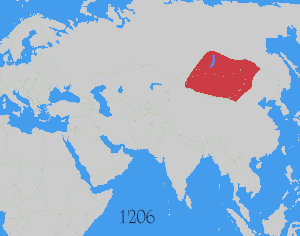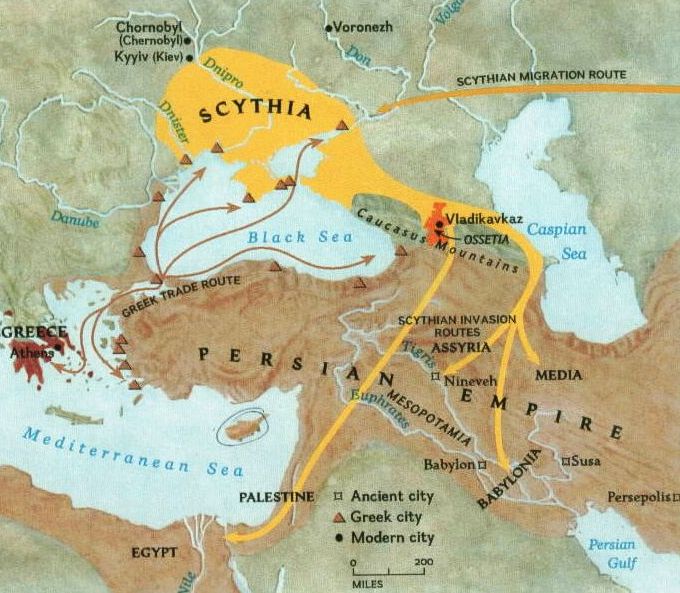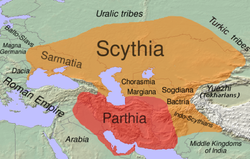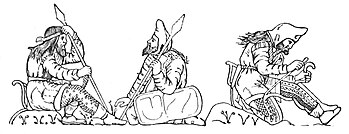Sorry to disappoint you but
all* the
ancient DNA tests done in Central Asia during the Scythian period (600 BCE - 300 AD) turned out to be exclusively R1a1. That's one of the best studied region in term of ancient Y-DNA. The older Andronovo samples were also R1a1, and so were the Tocharian ones from Xinjiang.
* 8 out of 8 skeletons in Scythian kurgans tested in 3 separate studies.
actually, following this clue, I wanted to see who are the indo-scythians who were the reason I decided later Turkish invasions couldnot have brought C3 so much south...
The Indo-Scythians are commonly thought to have been a branch of Sakas (Scythians), who migrated from southern Siberia into Bactria, Sogdiana, Arachosia, Gandhara, Kashmir, Punjab, Gujarat, Maharashtra and Rajasthan, from the middle of the 2nd century BCE to the 4th century CE.
http://en.wikipedia.org/wiki/Indo-scythians
Sakastan or Sakaistan or Sakasthan (Sanskrit: शकस्तान) is a term indicating certain regions of Western Afghanistan, Southwestern Pakistan and Eastern Iran where the Scythians or Sakas settled around 100 BC
http://en.wikipedia.org/wiki/Sakastan
I think you might be right here...
indeed according to the position of Sakastan(Western Afghanistan, Southwestern Pakistan and Eastern Iran), Sakas tribe of Scythians who were Indo-Scythians seems to be R1a...
It is clear that the Greek and Latin scholars cited here believed, all Sakai were Scythians, but not all Scythians were Sakai.[4] It seems likely that modern confusion about the identity of the Scythians is partly due to the Persians. According to Herodotus, the Persians called all Scythians by the name Sakas.
http://en.wikipedia.org/wiki/Sakas
this explains why R1a doesnot show traces of shape alike to Scythia...
they were just one of the tribes...
Btw. Arabs had similar name for Slavs - Sakalibe
however, this is area of Aria, so if they settled Aria only around 100BC than they couldnot have been Arians, which is contradictory from what we may expect based on haplogroup found in Brahmins
btw. next to Aria is island of C3 that made a whole in the R1a settled area... but Scythians / Sakas have supposedly come from south Sibir and C has come from Mongolia to east and little part went deep on south and settled next to Aria
actually this C came with Mongols of Genghis Khan
Back to Scytians
They were surely mixed, but their elite seemed to be overwhelmingly R1a1 based on the remains of several tombs scattered over very different locations, separated in time by many centuries.
If C3 did come only from the 4th century with the Turkic migrations, then the Scythians probably belong for the biggest part to R1a1 (I'd say over 60%, perhaps even 80%), with a sizeable N1 minority, some I2a2 and G1, and traces of R1b1b1, R1b1b2, G2a and J2.
this also makes sense...
e.g. G shows nice Scythia like spread...which cannot be seen with R1a since it came from further north anyway...
according to mix of haplogroups that you assume, Scythians seems to have been more cultural issue than a tribe...
I think original Scythians were G, while R1a were Sakas who were the largest Scythian tribe...
but I am not sure about N. It might have come with Turks..
Can it be that Scythians origin from Hittite who perhaps went to Caucasus after fall of their empire...?
Are G haplogroups alike in Caucasus, Iran and in Asia minor?
names do have some similarity
(S)Hettite => Scythian












